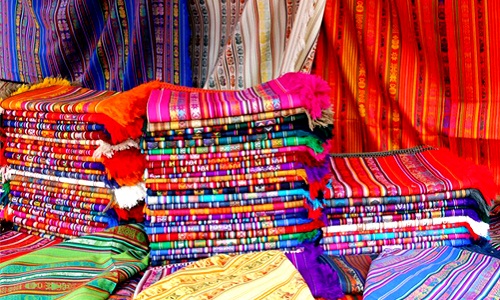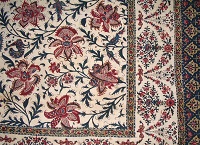"With a perfect ecosystem from fibre to fashion, both in cotton and man-made fibre, an abundant and young labour force, a vibrant domestic market and a good second largest exporter of textiles, apparel and made-ups in the world, textile industry has been a toast of the world. Though, India imports less apparels and made-up, there are specific segments where import is growing rapidly. These include Moisture Management Fabric (MMF) and technical textiles. With wage cost rising and Yuan gaining strength, apparel industry is moving away from China, thereby creating a potential market of $280 billion and more for other countries."
With a perfect ecosystem from fibre to fashion, both in cotton and man-made fibre, an abundant and young labour force, a vibrant domestic market and a good second largest exporter of textiles, apparel and made-ups in the world, textile industry has been a toast of the world. Though, India imports less apparels and made-up, there are specific segments where import is growing rapidly. These include Moisture Management Fabric (MMF) and technical textiles. With wage cost rising and Yuan gaining strength, apparel industry is moving away from China, thereby creating a potential market of $280 billion and more for other countries. India has the biggest chances to capture this growth. Ratika Jain of CII highlights some of the challenges plaguing the growth and what can be done to eradicate those problems.
Challenges on the way ahead

Setting and scaling up: The largest Indian apparel and made-ups factory employs 3,000-4,000 people, large Chinese factories employ over 10,000 people at one place. Some even employ up to 30,000 people. Though attempts have been made to increase the scale in Indian industry but the key issues revolve around labour, land and building, enabling infrastructure such as power and connectivity.
Unfavourable labour environment: The fear of managing large number of employees has discouraged several enterprises from growing. Some states have introduced progressive reforms, still there’s not worthy progress in sight. Issues related to land acquisitions have deterred entrepreneurs from venturing into large scale manufacturing. Our clusters are fragmented and lack clear positioning in the minds of buyers.
High operating cost: It has two aspects. The cost side pressures such as tax, power, wage, wage increases and other is labour productivity. The sector is highly labour intensive. Wage cost can go up from 6 to 8 per cent of the overall cost base in yarn to as high as 30-40 per cent in the case of apparel. Synthetic value chain is poor despite huge raw material base. The lack of local fabric at the right quality and at competitive prices leads us to resort to importing MMF fabrics. This result in loss of drawback on exports of apparel made from such imported fabric. Another issue is differential treatment of cotton. Energy cost is higher in Gujarat and Maharashtra compared to rest of the country, where fabric and yarn production is concentrated. Labour productivity is poor than countries like Bangladesh, mainly due to poor working conditions, insufficient training and high attrition rates.
Market barriers: Higher duty on synthetics and lower drawbacks as compared to competitors is another major factor. This make synthetic segment uncompetitive. The cost disadvantage ranges from 2 to 11 per cent. China has maximum VAT rebate for textile and apparel exporters of 17 per cent, whereas India allows a drawback of around 7-11 per cent.
Logistics challenges: Be it land ports or ports, customs procedures and clearances take more time than other countries. India suffers 2-3 week disadvantage against China and one week gap against Vietnam on logistics.
The way ahead
Since the industry is labour intensive, introduce flexible labour laws; job linked support schemes, innovative hub and spoke models for apparel/textile parks to employ labour in hinterlands and introduce PPP models for Industry to provide scale and create jobs. In India, share of companies with revenue more than 200 million is 3 per cent while in China, it is 14 per cent and in Bangladesh, it is 7 per cent. Bridge the operating cost gap, especially on synthetics. Entrepreneurs need to aggressively drive up productivity by investing in world class facilities, process improvements and build a culture of manufacturing excellence. Simplified tax structures and neutral implementation of GST for both cotton and synthetic products will give the much required boost to the industry. Infrastructure, especially at ports, import facilities and clearance procedures should be streamlined to cut turnaround times.
Signing FTAs with major markets like the European Union can equalise market access positions with key competitors like Bangladesh. Bangladesh has zero duty access to EU, Vietnam is on its way, India has 10 per cent duty, while China has 12 per cent duty on cotton shirt. Increased investments in technology, especially processing and technical textiles either through capital subsidy or technology partnerships. The A-TUFS released in December 2015 has taken welcome steps in this respect. Indian entrepreneurs need to invest both financial and human resources on technology and innovation to address the constantly evolving markets. Investments are required in technical textiles, processing, and apparel making in particular.
India needs to create its own 'Silicon Valleys' for technical textiles, with a full ecosystem of investors, start-ups, production facilities and ultra-fast clearances. Ease of doing business is equally critical for innovation, concludes Jain.













